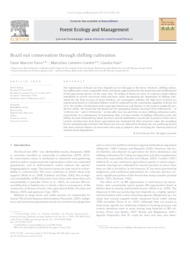Brazil nut conservation through shifting cultivation.
Brazil nut conservation through shifting cultivation.
Author(s): PAIVA, P. M.; GUEDES, M. C.; FUNI, C.
Summary: The regeneration of Brazil nut trees depends on tree-fall gaps in the forest. However, shifting cultivation fallows also create comparable biotic and abiotic opportunities for the dispersion and establishment of this gap-loving species. At the same time, the ability of Brazil nut trees to resprout enables fallow individuals to survive successive slash-and-burn cycles. Recognizing the importance of shifting cultivation for the food security of forest dwellers, we investigated whether the high level of Brazil nut regeneration found in cultivation fallows could be explained by the resprouting capability of Brazil nut trees, the number of cultivation cycles, past agricultural use and distance to the nearest conspecific productive adults. We found that the Brazil nut tree population density increased from 8.86 trees ha?1 to 13.69 trees ha?1 and 27.09 trees ha?1 at sites after one, two and three or more shifting cultivation cycles, respectively. As a consequence of resprouting, after a certain number of shifting cultivation cycles, the fallows become dominated by Brazil nut trees, and the landholders may decide to preserve them and to exclude enriched sites from future agricultural use. Protected for their extractive value, the secondary forests spontaneously enriched with Brazil nut trees are allowed to develop into nut-producing forests that have reduced chances of conversion into crops or pastures, thus reversing the classical process of Amazon forest degradation.
Publication year: 2011
Types of publication: Journal article
Unit: Embrapa Amapá
Observation
Some of Embrapa's publications are published as ePub files. To read them, use or download one of the following free software options to your computer or mobile device. Android: Google Play Books; IOS: iBooks; Windows and Linux: Calibre.
Access other publications
Access the Agricultural Research Database (BDPA) to consult Embrapa's full library collection and records.
Visit Embrapa Bookstore to purchase books and other publications sold by Embrapa.

